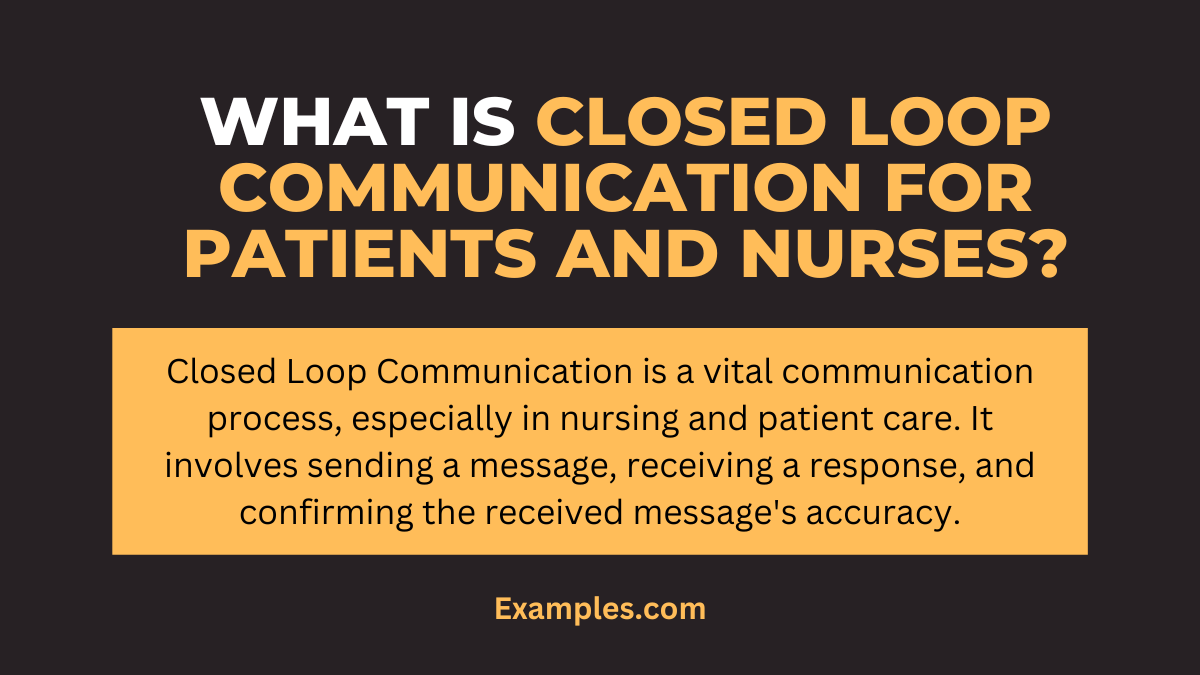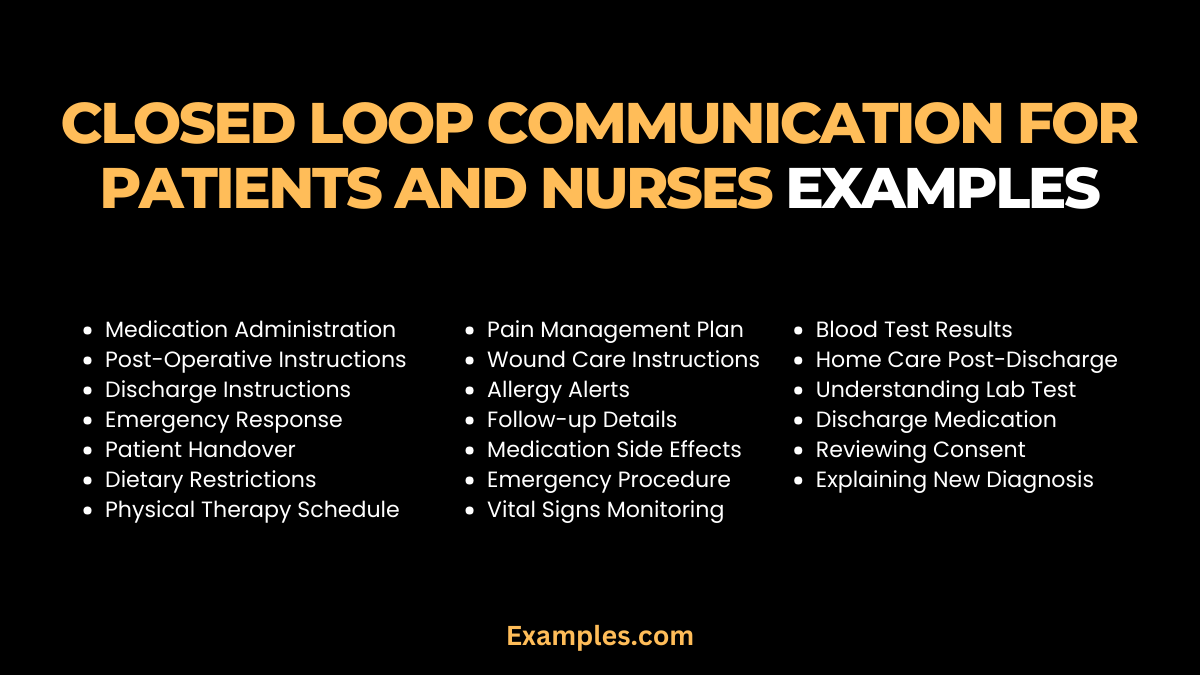19+ Closed Loop Communication for Patients and Nurses Examples
“Closed Loop Communication for Patients and Nurses” is a comprehensive guide designed to foster effective communication in healthcare settings. This guide delves into the nuances of closed-loop communication, offering real-world examples that demonstrate its importance in enhancing patient care. By emphasizing clear, concise exchanges between nurses and patients, this resource underscores how vital accurate information relay is for patient safety. Through various scenarios and practical tips, this guide equips healthcare professionals with the necessary skills to ensure every message is received, understood, and verified, thus reducing medical errors and improving overall healthcare outcomes.
What is Closed Loop Communication for Patients and Nurses? – Meaning

Closed Loop Communication is a vital communication process, especially in nursing and patient care. It involves sending a message, receiving a response, and confirming the received message’s accuracy. This method ensures that the information is correctly understood and acted upon. In healthcare settings, What is Closed Loop Communication is crucial for patient safety, as it eliminates misunderstandings and errors. It’s one of the Essential Actions for Closed Loop Communication that nurses use to verify patient needs, medical instructions, and care plans, enhancing overall patient care quality.
Download Closed Loop Communication for Patients and Nurses Now in PDF
20 Closed Loop Communication for Patients and Nurses Examples

Closed Loop Communication is integral to nursing, ensuring clarity and accuracy in interactions with patients. This communication model involves a nurse conveying information, the patient or another healthcare professional acknowledging and repeating the information back, followed by a confirmation from the nurse. This cycle helps in reducing misunderstandings and medical errors, thus playing a critical role in Closed Loop Communication in Healthcare. The Closed Loop Communication Steps involve clear communication, active listening, acknowledgment, and confirmation, crucial for accurate and effective healthcare delivery. The following examples illustrate how this method can be implemented effectively:
- Medication Administration: A nurse informs a patient about a new medication and dosage. The patient repeats the information back, and the nurse confirms it, ensuring the patient understands the prescription correctly.
- Post-Operative Care Instructions: After surgery, a nurse explains post-operative care procedures to a patient. The patient then articulates their understanding of these steps, and the nurse acknowledges or corrects their comprehension.
- Discharge Instructions: Before discharging a patient, the nurse explains the home care instructions. The patient repeats these instructions, and the nurse corrects any discrepancies, confirming the patient’s understanding.
- Emergency Response: In an emergency, a nurse instructs a colleague to fetch specific equipment. The colleague repeats the instruction to confirm they understood it correctly before proceeding.
- Patient Handover: During a shift change, a nurse hands over patient details to the incoming nurse, who repeats back key information to confirm understanding.
- Dietary Restrictions Communication: A nurse informs a patient about specific dietary restrictions. The patient repeats these instructions, ensuring they understand their dietary limits.
- Physical Therapy Schedule: A nurse explains the schedule for physical therapy sessions to a patient. The patient acknowledges and repeats the schedule to confirm their understanding.
- Pain Management Plan: A nurse discusses a pain management plan with a patient. The patient then restates the plan, allowing the nurse to confirm they’ve understood it correctly.
- Wound Care Instructions: Post-surgery, a nurse instructs a patient on wound care. The patient repeats these instructions, ensuring they know how to care for their wound properly.
- Allergy Alerts: A nurse informs a patient about potential allergens in medications. The patient acknowledges and repeats this information, which the nurse confirms.
- Follow-up Appointment Details: A nurse provides details about a follow-up appointment. The patient restates these details to ensure they understand when and where their next appointment is.
- Medication Side Effects Information: A nurse explains possible side effects of a medication. The patient repeats these side effects to confirm their understanding.
- Emergency Procedure Explanation: In a critical situation, a nurse quickly explains an emergency procedure to a colleague. The colleague repeats the procedure back for accuracy.
- Vital Signs Monitoring Instructions: A nurse instructs a patient on how to monitor their vital signs at home. The patient repeats these instructions, ensuring they can accurately monitor their health.
- Blood Test Results Explanation: A nurse explains blood test results to a patient. The patient repeats back their understanding, allowing the nurse to confirm or correct their comprehension.
- Home Care Instructions Post-Discharge: A nurse outlines home care instructions after discharge. The patient restates the instructions, clarifying their post-discharge care routine.
- Understanding Lab Test Procedures: A nurse describes the process for an upcoming lab test. The patient repeats back the process, ensuring they know what to expect.
- Discharge Medication Regimen: A nurse explains a new medication regimen upon discharge. The patient repeats the regimen, confirming their understanding of the dosage and timing.
- Reviewing Consent for a Procedure: Prior to a procedure, a nurse reviews consent information. The patient restates their understanding and agreement, ensuring informed consent.
- Explaining New Diagnosis: A nurse explains a new diagnosis to a patient. The patient repeats back their understanding, allowing the nurse to address any misconceptions or questions.
Why Closed Loop Communication is Important for Patients and Nurses?
Closed Loop Communication is crucial in nursing due to its role in ensuring patient safety and effective healthcare delivery. It helps in:
- Preventing Medical Errors: By confirming and re-confirming critical information, Closed Loop Communication reduces the likelihood of misunderstandings that could lead to patient harm.
- Enhancing Patient Care: This communication style facilitates clearer understanding between nurses and patients, leading to better care and treatment outcomes.
- Building Trust: Effective communication fosters a sense of trust and security in patients towards healthcare providers.
What are Closed Loop Communication Techniques for Nurses to Avoid Patient Harm?
To enhance Closed Loop Communication in nursing:
- Repeat Back/Read Back: Nurses confirm the accuracy of received instructions by repeating or paraphrasing them back to the sender. This technique ensures both parties have a mutual understanding.
- Clarify Uncertainties: In case of any doubts or unclear points, nurses should proactively seek clarification. This step is crucial to prevent misunderstandings and ensure precise patient care.
- Summarize Key Points: During patient-nurse interactions, summarizing critical information can help maintain clarity and ensure that both parties have aligned understandings of the care plan.
- Use Simple Language: Effective communication with patients often requires avoiding complex medical terminology. Using straightforward language facilitates better understanding and compliance from patients.
- Regular Training: Continuous training in Closed Loop Communication in Nursing and Closed Feedback Loop Communication enhances communication skills and awareness.
By implementing these techniques, nurses can significantly mitigate the risk of patient harm, illustrating the Importance of Closed Loop Communication in healthcare settings.
How to Make Closed Loop Communication for Patients and Nurses?
Implementing Closed Loop Communication for Patients and Nurses involves a systematic approach:
- Start with Clear Communication: Nurses should begin with explicit, straightforward instructions or information, ensuring clarity from the onset.
- Encourage Acknowledgment: The receiving party, be it a patient or another healthcare professional, should acknowledge by repeating the message, confirming their understanding.
- Verification by Sender: The nurse then needs to confirm that the message has been correctly understood by the receiver, ensuring accuracy.
- Documentation: It’s crucial to document key communications in medical records for accuracy, continuity of care, and legal documentation.
This approach is particularly critical in Closed Loop Communication in Medical situations, ensuring precise and effective communication between nurses and patients.
Tips for Nurses to Improve Patient Safety with Closed Loop Communication
To enhance patient safety through Closed Loop Communication, nurses should:
- Practice Active Listening: Actively engage in listening to ensure full message comprehension and effective communication with patients.
- Clarify and Confirm: Always seek clarification and confirmation to eliminate misunderstandings in healthcare communication.
- Use Non-Verbal Cues: Be mindful of non-verbal cues, as body language can enhance or hinder message reception.
- Educate Patients: Empower patients by educating them about Closed Loop Communication, encouraging their active participation in their healthcare.
- Continuous Training: Healthcare professionals must undergo ongoing training to understand and implement Closed Loop Communication effectively.
- Feedback Mechanism: Establish feedback systems to gather input and enhance communication techniques continuously.
- Patient-Centered Approach: Customize communication to cater to the unique needs and preferences of each patient, promoting patient-centered care.
Implementing these strategies can significantly improve communication and patient safety in nursing practice.
Why is Closed Loop Communication Used in An Emergency?
Closed-loop communication is used in emergencies to ensure accurate, clear information exchange and immediate confirmation, reducing the risk of misunderstandings in high-stress situations.
What is an Example of a Closed-Loop Communication for Patients and Nurses?
An example: A nurse instructs a patient to take medication every four hours. The patient repeats this back to confirm their understanding, and the nurse acknowledges the correct repetition.
How Do You Communicate With a Trauma Patient?
Communicate clearly, calmly, and directly. Use simple language, ensure the patient’s understanding, and utilize closed-loop communication for critical instructions.
What is Closed-loop Communication during Out of Hospital Resuscitation?
In out-of-hospital resuscitation, closed-loop communication involves clear, direct verbal instructions with immediate feedback to confirm understanding and actions, ensuring effective coordination during the resuscitation process.
Statistics Highlighting the Closed Loop Communication for Patients and Nurses
Statistical studies have shown the effectiveness of Closed Loop Communication in various healthcare scenarios. For example, a study conducted on operative teams demonstrated that directed communication, a key aspect of CLC, increased the likelihood of eliciting a response by at least 50% in periods preceding acute changes in the clinical setting??. This underscores the importance of CLC in improving communication patterns, especially during critical situations in healthcare.
Closed Loop Communication (CLC) in nursing not only enhances patient care but also plays a crucial role in team dynamics and the overall efficiency of healthcare services. The implementation of CLC has been linked to reduced rates of medical errors and improved patient outcomes.
For instance, a study highlighted in the Journal of Nursing Management found that effective communication, including CLC, reduced incidents of patient harm and enhanced team collaboration. This study emphasized the importance of clear and concise information exchange in complex healthcare environments??.
Additionally, research published in BMJ Quality & Safety indicates that CLC improves information transfer in clinical crises. This is particularly important in high-stress situations where clear communication is vital for patient safety and effective team response??.
For further information and in-depth analysis of CLC in nursing, additional resources and research articles can be accessed through medical journals and healthcare websites. These sources offer valuable insights into the practical application of CLC and its impact on patient care and healthcare team dynamics.



